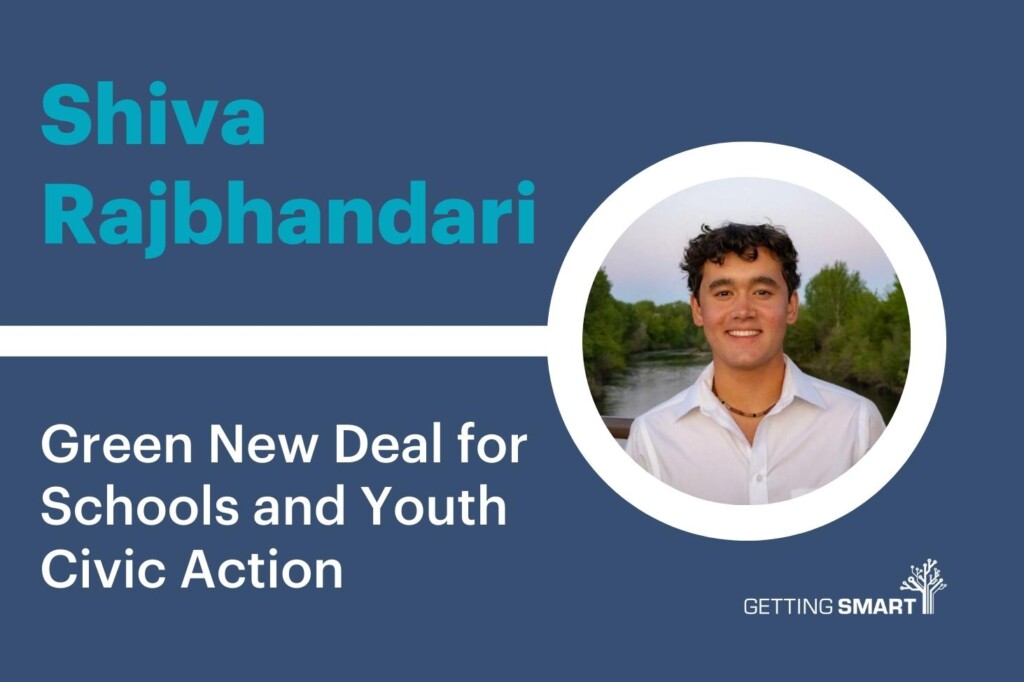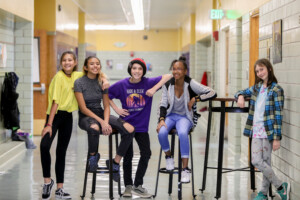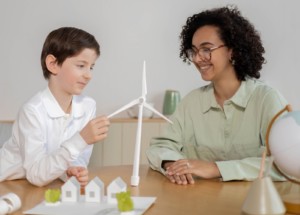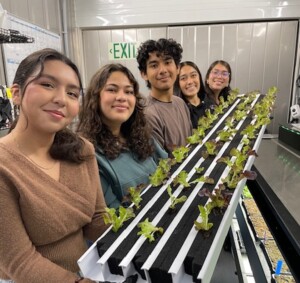Shiva Rajbhandari on Hope, Green New Deal for Schools and Youth Civic Action
Key Points
-
Students on the school board should not be a headline, it should be the norm.
-
Climate education is a critical part of preparing young people for confronting real world problems.

This episode of the Getting Smart Podcast is brought to you by our recent publication Green Pathways, and makes the case for why ALL pathways need sustainability and green embedded. Find out more here.
On this episode of the Getting Smart Podcast Mason Pashia is joined by Shiva Rajbhandari, a current freshman at UNC Chapel Hill and avid climate and education activist who is, to date, the first student on a school board in the state of Idaho.
We’re releasing this episode near the beginning of COP28, an international gathering of national leaders who are setting goals, discussing science and trying to make a collective movement toward net zero emissions to avoid worsening the climate crisis. This conversation with Shiva highlights the myriad ways youth are helping raise awareness of climate-related issues, what school taught them to do and how to organize large groups of people to come together for a common cause.
Links:
- School Board Activist Shiva Rajbhandari
- Idaho Climate Justice League
- The Sierra Club
- Green New Deal for Public Schools Act
- COP28
- Green Pathways
Transcript
Mason Pashia: Welcome to the Getting Smart Podcast. I’m Mason Pashia. Today, I’m thrilled to be joined by Shiva Rajbhandari, a current freshman at UNC Chapel Hill. Shiva is a climate and education activist who is the first student to date on a school board in the state of Idaho, where he went to high school.
Shiva Rajbhandari: Yeah, thanks for having me on, Mason.
Mason Pashia: Great to meet you, Shiva. You bet. So, I was doing a little bit of digging on the internet and found that climate change is sort of the first thing that seems to have really grabbed you from the level of activism. You cited a seventh-grade encounter with it, I believe. Give me a little bit of context. How did you encounter climate change for the first time?
Shiva Rajbhandari: Yeah, gosh, I was in seventh grade and I took earth science, which is a required course. We had about a two-week unit on climate change, which I later learned is actually pretty rare in Idaho because climate change at the time was not part of our state K-12 science standards. But yeah, we talked about the greenhouse effect, coral bleaching, and how the icebergs are melting. It was scary because I care about the coral reefs and the icebergs. But then, as I started to dive deeper and learn more about the climate crisis, I learned it’s more than just the animals in the ocean that are being affected. It’s real people and real human lives that are on the line. I remember learning about Hurricane Maria in Puerto Rico that killed more folks than 9/11. I remember hearing about these fires in California that burned entire towns to the ground because the forest was so dry and the winds were so fast. I particularly remember learning about my dad’s home country, Nepal, where the Himalayan glaciers are receding at such a rate that it could destabilize the entire Indian subcontinent by 2100 and deny millions of people basic water and food. That really scared me. So, for the next year and a half after learning about all these things, I did what corporations and the world tell us to do about the climate crisis. I became a master of our city’s recycling system, started taking cold showers, and begged my parents to go vegetarian. I just remember sliding into this pit of climate despair and paralysis from climate anxiety. I remember one time we were going to Utah, and my mom was going to drive us down to see her parents in Salt Lake. I was just furious that we were going to drive four hundred miles in our gas-guzzling Prius to see my grandparents. It was really difficult. I remember one day, maybe a year into this climate anxiety time in my life, looking around and seeing all these things I had been doing. I hadn’t bought new clothes, hadn’t taken a warm shower, I was composting all my food scraps, and nothing was changing. Another report had just come out detailing that we were just one step closer towards global climate collapse and warming over 1.5°C. It was really hard. But then I remember that all changing my freshman year of high school when I was walking with my friends after school in mid-September and saw this bright yellow sign that said, “Boise Climate Strike this Friday at the Capitol.” I didn’t use Google Calendar much at the time, but I remember setting five calendar notifications for this climate strike. I really wanted to go. So that Friday, my friends and I walked out of school and walked down from North Junior High to the Idaho Capitol, about seven blocks. Like a lot of state capitols, the Idaho Capitol is built to hide protests, so you can’t tell if anyone’s there as you’re pulling up. But I remember turning left on Jefferson Street and seeing the Capitol steps and seeing not a hundred, not a thousand, but over 1500 of my peers, junior high kids just like me, standing on the steps demanding our leaders take action, demanding an end to fossil fuels. All the weight I carried around for the last two years turned into a sense of empowerment and maybe we really can do something about this crisis. All the guilt and shame I felt turned into a sense of anger as I realized the people causing this crisis are not folks like you and me, they are wealthy fossil fuel billionaires and the politicians who serve them, willing to sell our planet and our future down the line for a couple of bucks. I haven’t left the movement since then because I know this is the only way, and I’m excited to do whatever I can to take down the fossil fuel industry and the climate crisis.
Mason Pashia: I love that. That’s quite the journey. I want to go back to something you said at the beginning, and then we’ll get back to where you left us. You said you were doing the things that TV tells you to do to stop the climate crisis, like cold showers and recycling. What did the climate curriculum tell you to do? It sounds like it was scary to hear these things, but was there any sort of pivot towards action? How implicated were you? Can you spend a little time reflecting on that?
Shiva Rajbhandari: Yeah, I’m trying to think. Boise has really led the state with our K-12 climate curriculum. I was really lucky to have the climate education that I did, and then later on to be able to take a class at Boise State University specifically focused on climate change. But back in seventh grade, the way we talked about climate change was as an individual issue, something we didn’t have the solutions to, caused by a myriad of factors. We kept talking about how there’s a scientific consensus and climate change is real and happening, but not a lot about what we needed to do to stop it. That’s something that’s changed a little bit since I graduated seventh grade, but it’s still a problem. We’re not really preparing students around this country to tackle the largest problem humanity has ever faced, the problem that will dominate my generation and many generations after for the rest of our lives. There definitely was room for improvement.
Mason Pashia: When you got to ninth grade, I believe you led a petition effort to get your school or district to adopt a climate action plan, a ten-year forecast. Walk me through that process. How did you identify that as the thing you needed to do, and what did it actually look like to try to get them to do it?
Shiva Rajbhandari: Well, it’s simple. School districts around the country have taken climate action for years and saved millions of dollars because fossil fuels are no longer a viable economic alternative to clean energy. Our generation cares the most about the climate crisis and will be affected the most by the decisions that people in power are making today. It just makes sense that our schools are leading the way towards the fossil-free future we deserve. I was part of a group called the Idaho Climate Justice League, students from all five high schools across the Boise School District working for a clean energy commitment and long-term sustainability plan for our schools. This has been done in liberal places like New York and California, but also in places like Salt Lake City, Utah, Denver, Colorado, Virginia Beach, and Miami. Everywhere schools took climate justice seriously, money was saved, resources were reinvested in students, and learning outcomes improved. There’s plenty of evidence showing that tackling the climate crisis and teaching climate change and preparing students to confront issues associated with global warming go hand in hand. We started asking our board members to take the climate crisis seriously. We got a petition with over a thousand signatures, the largest petition our school district had ever received. We wrote over 300 postcards to our board members, repeatedly asked for meetings, and were repeatedly turned down or ignored. There was this sense at the time that our district had bigger fish to fry and that student voices didn’t really know what they were talking about, which is not true. That’s when we started to demand more. We started to walk out, write op-eds, generate local media, host a city club forum, and invite our board members to sit on the forum. We held conversations with students in other school districts where climate action plans had been successfully implemented. Ultimately, we were successful in pushing our board to adopt a collective commitment on clean energy, which was a somewhat watered-down version of what we’d asked for but represented a major shift in the decision-making process in our school district. As far as we knew, our district had never bent to public pressure, especially from students, in such a way.
Mason Pashia: Great job. That’s awesome. Where did you learn those mechanisms of civics, like the idea of doing a forum or writing postcards and petitions?
Shiva Rajbhandari: From the beginning in Boise schools, my teachers have always told us our voices matter and we can make a difference. We learned about the civil rights movement, World War II, and the Great Depression, and how society came together and brought about massive change that people repeatedly told them was not possible, that they were dreaming too big. It made sense that if we cared about the climate crisis enough, we should be able to force our district to take real action. We were lucky to have mentorship from the Sierra Club and being part of Sunrise and Extinction Rebellion, seeing this mass movement around the world calling on governments to take ownership of this crisis, helped inform a lot of our decision-making. It was truly a student-led group, and we definitely learned a lot along the way.
Mason Pashia: Yeah, I’m sure. Thinking back to when I went through school, some of those talking points were still on the syllabus, but there was no pivot towards this is how you also do it. It was like these people in history had to do this at one point, but it was not like, “And now the tools are in your hands.” That’s a huge testament to Boise schools that they make you feel all the time that your voice matters and people want to hear from you. That’s amazing.
Shiva Rajbhandari: Absolutely. Every time, it’s my teachers. That’s how I got here. It’s really public schools that made me who I am.
Mason Pashia: That’s incredible. I want to make that a huge blurb everywhere, just “Shiva says.” You mentioned a couple of really amazing collective social movements in that anecdote, both Extinction Rebellion and Sunrise. You’re currently working with them on their new Green New Deal for Schools program. Give me a little bit of information about Green New Deal for Schools, and then I want to understand how participating in these has both shaped what you think young people need to be aware of and good at and how you now understand collaboration in a new way.
Shiva Rajbhandari: Absolutely. We know that we need to completely transform our economy from one that relies on extraction and exploitation to one that relies on regeneration where we can all share in our collective prosperity. We know that capitalism and colonization are the roots of the climate crisis, and there is only one plan that addresses the climate crisis at the speed and scale that science requires and justice demands, and that is the Green New Deal. One component of the Green New Deal, when we talk about this mass transformation, World War II-era mobilization against the climate crisis, is schools. This is the most important component for several reasons. First, schools are in every community across this country, and they are cornerstones of how Americans interact with our government and one another. If we transition our schools to 100% clean energy, we begin that transition in Americans’ minds and show what climate action looks like on a local scale in every community across this country. That’s powerful. Second, the climate crisis is fundamentally a youth issue. Generation Z cares about it far more than the people currently making decisions, and it’s something we can organize and mobilize towards. Third, we need to prepare young people to graduate high school ready to enter jobs addressing the climate crisis today. We don’t have time to wait for folks to get their PhDs and figure out what to do. We know what must be done: end fossil fuels, invest in clean energy, and repair the massive inequities exacerbated by the climate crisis. There are good-paying jobs we can put folks to work in right out of high school, and we need to prepare students for those careers. The Green New Deal for Schools addresses all these things. The Green New Deal for Public Schools Act is a $1.4 trillion bill introduced by Congressman Jamaal Bowman. It’s the Green New Deal legislation with the most co-sponsors in Congress. This bill would allow schools across the country to radically transition to clean energy at an unprecedented rate, get the lead out of the pipes, asbestos out of the ceilings, and make sure our buildings are safe and clean for all students. It would make school lunch free and end the idea of lunch debt and childhood hunger, which is massively affected by the climate crisis, and create climate disaster plans and pathways to green jobs so that schools are ready to respond when our communities are broken by climate disasters. Students all across this country are organizing to make this happen in their school districts because we know there’s already money out there. Many school districts can already make this transition. The Inflation Reduction Act has many provisions that make it economical for schools to transition to clean energy. Now it’s not even a question of whether you have the money upfront; it’s cheaper to build a net-zero school on day one. That’s radical and incredible, and it’s something we brought about by organizing for a Green New Deal.
Mason Pashia: You bring up such critical points. One that often gets overlooked when talking about climate change and clean energy is the baseline level of health for people. Clean energy is cleaner for people as well as the planet. Sometimes it’s harder to make the case for caring about the planet, which baffles me, but sometimes it is. However, there’s this other piece: it’s better for every single person in every part of their life if we transition to clean energy.
Shiva Rajbhandari: Absolutely. I care about the planet. I grew up in Idaho. People don’t live in Idaho for the projects; they live there for the land, the mountains, and the rivers. I love everything about my home state. But really, I am in this fight for the people. I know what the climate crisis does to families. I know what it looks like to have schools that are chronically underinvested in and then see the effects of massive ecological damage, hurricanes, fires, and floods. I know that we deserve better, and young people deserve better. We can build a world where the economy works for working people, where everybody has a good-paying union job, and where folks don’t have to grow up in fear of the next natural disaster, knowing their community is there to support them.
Mason Pashia: I’m curious. Participating in these organizations and movements, what skills do you think you have now that you didn’t have before? How has it reframed your understanding of collaboration and collective action?
Shiva Rajbhandari: Organizing for climate justice has informed my approach to politics and my understanding of how we bring about change in this country. It has always been through social movements and changing the political common sense. I grew up in a community that values family and centers family as the unit for change. Families are the unit for change because I’ve seen what happens when we organize and make something like the climate crisis undeniable and unavoidable by the people in power. They go home to their kids, have conversations because their kids saw it on the news, and slowly but surely, American political common sense changes. We realize we can be whatever we have the courage to see. If that is a Green New Deal economy, then that’s what we can build together. This can be applied to many social issues. The climate crisis intersects with all of them. I’ve started to see things more intersectionally. In terms of hard skills, the skills I’ve learned through organizing protests, running for the school board, and creating public comment on NEPA protocols transfer into everything I do. The way I approach school, my coursework, and my relationships with peers, and my understanding of who I am and what I can achieve have all been influenced. Hearing that we can do anything if we put our minds to it is one thing, but once you believe it, it’s freeing, and the potentials are endless.
Mason Pashia: We would probably call all those skills durable or transferable skills. They are arguably the most important. The last few months, I’ve been trying to wrap my head around how to say this in a helpful way. I really think community organizing is the skill of the future. Every single important job will require community organizing because we are doing massive infrastructure and local and global change movements. Everyone will need some capability in that. It’s incredible that you’re getting it as young as you are and as often as you are. You definitely have that skill in spades. My background is in the arts, and I see it even with artists. Artists now are community organizers, getting different voices to contribute to the same whole. That’s going to keep happening more and more in the creative space as well. It’s rampant everywhere.
Shiva Rajbhandari: Absolutely. Community organizing is what America was built on. It’s why this country has been able to change the world and what it means to be free. It’s invaluable.
Mason Pashia: You mentioned the school board a couple of times. I want to talk about that briefly. What made you want to run for it, and what have you learned about how schools work and the role that activism can play in reshaping schools?
Shiva Rajbhandari: To understand why I ran for the school board, we have to go back to the conversation about the clean energy commitment and long-term sustainability plan for our schools. After our board passed this collective commitment on clean energy, we were pretty angry. We had been subverted from the process and felt the resolution they passed was not enough to meet our demands. We started looking at school districts across the country that had strong climate action plans and found that almost all of them had a student on the board. It makes sense because students have a lot to bring to the table. We’re on the ground every day in our classrooms, and most board members are not. We built vast networks of folks who interact daily with our school districts. Students are the cornerstone stakeholders in educational decision-making and are consistently left out. When a friend applied for an open seat on our school board and didn’t even receive an interview, I started looking into running for the board. I realized the school board election was just seven days after my eighteenth birthday, so I would be old enough to run. In June before my senior year, I brought together the folks from the Idaho Climate Justice League who had worked on the clean energy campaign for our school district, and we made a plan to run for the board. That summer, we knocked on over five thousand doors, raised over ten thousand dollars, and turned out over twenty thousand people to vote in the largest school board election ever in our district. We defeated an incumbent endorsed by extreme paramilitary groups pushing book bans and targeting our LGBTQ+ students with a campaign of climate action and addressing the mental health crisis in our schools. I was elected to be the first student ever on the Boise School Board, and hopefully not the last.
Mason Pashia: Congratulations again. That’s amazing. Would you suggest if you could wave a wand, making the entry age to be on the







0 Comments
Leave a Comment
Your email address will not be published. All fields are required.